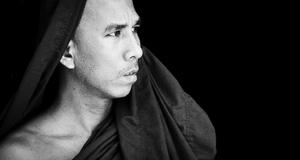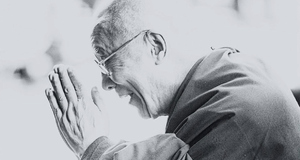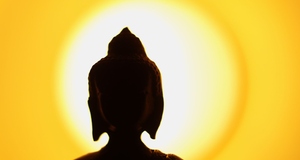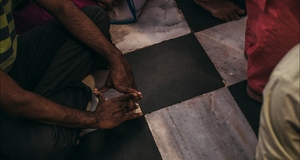Featured Article:The Kakawin Sutasoma: A Look at Bhinneka Tunggal Ika and Perceptions of the Text's Religious Implications
By
2015, Vol. 7 No. 09 | pg. 3/3 | « Most other informants would disagree. Pak Inengah Purnah, who said that Kala cannot be equated to Siwa, concluded that the conflicts cannot represent Buddhist superiority. Pak Bramantyo wrote that it depicts the “power of enlightened wisdom and compassion against our own passion and taint.” Pak Buana said that instead of a conquering of Siwaism, the conflicts can be seen as a purification of Siwaism and of a union of the the two religions to balance the differences and to find peace. This union and balance of the two religions that Pak Buana related is a concept touched upon by almost all other informants. Regardless of their religious orientations, interpretations of the story, or interpretations of the characters, each informant emphasized the importance of harmony and the relations of the two religions. These ideas emerged largely within the context of the discussion of the phrase, “bhinneka tunggal ika.” During the interviews, each informant was asked to read the following and describe what it meant to them:Konon dikatakan bahwa Wujud Buddha dan Siwa itu berbeda. Mereka memang berbeda namun, bagaimana kita bisa mengenali perbedaanya dalam selintas pandang. Karena kebernaran yang diajarkan Buddha dan Siwa itu sesungguhnya satu Jua. Mereka memang berbeda-beda. Namun, pada hakikatnya sama. Karena tidak ada kebenaran yang mendua.9 Most informants, as well as a few published scholars, expressed the idea that Siwaism and Buddhism, although different in name, are essentially the same religion, each striving for a common goal. According to Pak Buana, the differences of the two religions are not differences in opinions, but differences in the ways of teaching and their implementations; these different interpretations and practices, however, all lead to the common goal of worshipping a single god. Pak Inengah Purnah’s response was nearly identical: Buddhism and Siwaism have one purpose – to make peace in the world – but it is achieved by means of different practices. Pak Sambere succinctly said that Siwaism and Buddhism are different but still one because they share the same purpose – they are only different in name. Pak Anom said that there is no reason to pit the two religions against each other because they are the same; these two (and other) gods have different names (Allah, Jesus, Buddha, etc.) but they are the same. Therefore, we must “care [for] other religions, we must [be like] brother[s].” Pak Sutjaja similarly stressed the importance of living in harmony and explained that although the two religions appear different, they are the same in reality. Pak Bramantyo wrote that “regardless of your approaching method, truth is truth, there is no second truth”; despite the various practices to gain truth, there is only one, single truth. These views are reflected in the published scholarship, as well. As Zuriati (2010) writes, “one of the important messages of the text is that, in essence, Buddha and Siwa share the same doctrine of truth. They are not different but rather form a unity in diversity” (p. 423). Zoetmulder (1974) also writes that the god is the “highest dharma (doctrine and ultimate reality) and final goal for all, whatever sect or school [an individual] may belong to, in the same way as the top of a mountain can be reached by people ascending it from various directions” (p. 335). In the introduction to their Sutasoma translation, Bramantyo and Mastuti (2009) write, “The effort to achieve the goal is possible by different methods but the goal is one and the same: Buddha and Siwa are one and the same” (p. xx).10 Instead of the idea that the two religions are separate paths to a common goal, some describe a merging of the two into a single religion. Pak Nartha, for example, said that Siwa and Buddha (or Kala and Sutasoma) were united into one, becoming a single entity, so that Siwa and Buddha can be considered as one. Hobart (1990) introduces her work with the comment, “the Old Javanese Sutasoma reflects the process of Siwa-Buddhism being absorbed into ‘guruism,’ i.e., a more indigenous conception of Siwaism and Mahayana Buddhism merging into a two-in-one deity” (p. 78). Two scholars look to the archaeological evidence of temple architecture to explain the phrase. Rahadhian (2011) compares the dualities evident in the shape, ground plan, and layouts of temples erected in worship of Siwa-Buddha, concluding that there is a syncretic “dialogue between the elements within […] [that] can become one in a single unit” (p. 135). Kinney (2003) similarly writes of the “merging of Hinduism and Buddhism into one religious system,” and describes how the five cosmic Buddhas (Wairocana, Akshobhya, Ranasambhava, Amitabha, and Amoghasiddhi) are equated to the five manifestations of Siwa (Sadasiwa, Rudra, Mahadewa, Brahma, and Wisnu) and can be worshipped simultaneously in one temple complex (p. 25). The incongruity of the sources’ claims of Buddhist superiority and their interpretations of “bhinneka tunggal ika,” however, remains unaddressed. How is it that Zoetmulder (1974), for instance, can declare that Kala’s submission to Sutasoma represents Buddhist superiority while simultaneously explaining that “bhinneka tunggal ika” means Siwaism and Buddhism are merely two paths to the same goal (p. 335 and 347)? Zuriati (2010) also makes seemingly contradictory remarks: Sutasoma and Buddhism are the “winners,” and yet, “Buddha and Siwa share the same doctrine of truth” (p. 423). It seems nearly impossible to explain this inconsistency. There is no doubt that the passage preaches the equality and sameness of the two religions, yet there seems to be no other way to interpret Kala’s submission to Sutasoma at the end than as Siwaism’s surrender to Buddhism. One possible explanation is that, similar to what Pak Buana said, the final conflict can be seen, not as Kala (or Siwaism)’s defeat, but as his acceptance of Buddhist ways. By acknowledging Sutasoma as its equal, Kala accepts the prince’s Buddhist teachings and is able to join Siwaism with Buddhism. This signifies the union which Pak Nartha had described: “Siwa and Buddha were united into one, to become a single entity.” This unification is reflected in some modern practices of Balinese Hinduism: there is a Hindu sect called Siwa-Buddha, in which Buddhist customs are incorporated into those of Hinduism. Pak Inengah Purnah, for example, explained that the practice of praying with incense and flowers was adopted from the Buddhist practices. Pak Nartha also explained that in Balinese Hinduism, there are two priests: a Buddha priest and a Siwa priest, and Pak Anom even equated the two, saying that Balinese people consider Buddha and Siwa to be the same being. In academia, one may say, we tend to over-analyze and make assumptions where there is no need for any. One may suppose that Mpu Tantular wrote this story without any intent to establish superiority of any religion over the other – it could merely be a simple story, or fairytale, as Pak Sambere said, with an archetypal hero facing various challenges. This seems not to have been the case, however. Mpu Tantular was a court poet who was commissioned to compose this story for Hayam Wuruk’s royal family. It is hardly deniable, therefore, that the Sutasoma is the result of the Majapahit empirical court’s specific political agenda. Whether that political agenda was Hindu-, Buddhist-, or otherwise oriented, however, is difficult to define, given the religious ambiguity of the time. Taking these complications into consideration, the best explanation that this study can attempt to provide is as follows. The Sutasoma was composed during a time when both Hinduism and Buddhism flourished, commissioned in order to advocate religious harmony and peace between the two religions. Thus, Sutasoma’s encounters with the Siwaite characters should be seen as representing the merging of Buddhism and Siwaism, rather than the superiority of one over the other. It is hardly deniable that this work is full of inconsistencies, contradictions, and ambiguities. To be crudely concise, this study fails to offer any groundbreaking discovery about modern interpretations of the Sutasoma and their dependence on individuals’ ‘horizons of expectations.’ There are no categorical ways, as far as this author is concerned, in which to organize the individuals’ responses according to any sort of consensus; no two individuals belonging to the same ‘interpretive community’ – whether it be determined by religious background, profession, education, age, or context in which an individual may know the Sutasoma – produced identical, or even similar, responses. It has hopefully been made clear that, although responses in neat agreement would have been ideal, it is often difficult to apply theory to practice, and that the fact that this study produced such a variety of interpretations itself is a testament to the variability and flexibility of the story. In exploring the modern reception of an ancient work of literature, obscurities resulting from individuals’ religious views and opinions, not to mention time (if the Sutasoma were a contemporary work, our questions could have been answered instantaneously), can only be expected. That is not to say, however, that this study is not without merit. By comparing the published works of nearly two-dozen scholars with each other and with the words of nine valued informants, this work demonstrates that a single work of literature can produce myriad responses and interpretations. This only highlights the fact that everything in the world is relative, conditioned, and impermanent. Perhaps it is impossible to create a single explanation for a literary work; the beauty of studying ancient literature lies in the exploration of these various interpretations. With a work such as the Sutasoma, which has inspired the national motto of Indonesia, a study of its modern reception naturally remains relevant. Thus, to borrow the words of S. O. Robson (1972), ancient literature, or the ‘classics’ are not “dead survivals from the past, but are a living part of the present, still playing an active role in society” (p. 309). ReferencesAoyama, T. (1986). 古ジャワ文学におけるスタソーマ物語の受容と変容. 東南アジア研究, 24(1), 3-17. Bacon, W. (1980). An aesthetics of performance. Literature in Performance, 1(1), 1-9. ___. (1984). Literature in Performance, 5(1), 84. ___. (1996). The dangerous shores – One last time. Text and Performance Quarterly, 16(4), 356-366. Bramantyo, H., & Mastuti, D.W.R. (2009). Kakawin Sutasoma. Jakarta: Komunitas Bambu, Ensink, J. (1967). On the Old-Javanese Cantakaparwa and its tale of Sutasoma. Gravenhage: Martinus Nijhoff, H., R. P. (2011). The persistence of ‘candi’ representation in modern architecture in Indonesia. International Journal of Engineering & Technology, 11(4), 134-141. Hall, K. R. (2005). Traditions of knowledge in Old Javanese literature, c. 1000-1500. Journal of Southeast Asian Studies 36(1), 1-27. Hobart, A. (1990). The enlightened prince Sutasoma: Transformations of a Buddhist story. Indonesia, 49, 75-102. Jauss, H.R., & Benzinger, E. (1970). Literary history as a challenge to literary theory. New Literary History, 2(1), 7-37. Johnsen, S. A. (2008). Outside points of view in the construction of Balinese ethnicity and religion. The Australian Journal of Anthropology, 19(3), 314-330. Kinney, A. R. (2003). Worshiping Siva and Buddha: The temple art of East Java. Honolulu: University of Hawai’i Press,. Martinez, A. (n.d.). Reader-response criticism: The revolt against formalist interpretations of literature. Presentation. Morgan, A. (2011). Language, literacy, literature: Using storytelling in the languages classroom. Babel 46(2/3), 20-29. Nala, N. (2004). The development of Hindu education in Bali. In M. Ramstedt (Ed.), Hinduism in modern Indonesia (76-83). London: RoutledgeCurzon,. Pigeaud, T.G. (1962). Religious belief and ecclesiastical organization in 14th century Majapahit. Koninklijk Instituut voor Taal-, Land- en Volkenkunde, 4, 79-193. Ricklefs, M. C. (1992). Unity and disunity in Javanese political and religious thought of the eighteenth century. Modern Asian Studies, 26(4), 663-678. Robson, S. O. (1972). The Kawi classics in Bali. Bijdragen tot de Taal-, Land- en Volkenkunde, 128(2/3), 308-329. Rubinstein, R. (2000). Beyond the realm of the senses: The Balinese ritual of kakawin composition. Leiden: KITLV Press, Santoso, S. (1974). The ‘Samaya’ of Bharadah and Kuturan. Indonesia, 17, 51-66. van der Tuuk, H. N. (1881). Notes on the Kawi language and literature. Journal of the Royal Asiatic Society of Great Britain and Ireland, 13(1), 42-58. Ven Der Meij, D. (2011). Kakawin Sutasoma and kakawin Nagara Krtagama [Review of the books Sutasoma: The ancient tale of a Buddha-prince from 14th century Java by the poet Mpu Tantular, by K. O’Brien, Kakawin Sutasoma by Mpu Tantular, by P.J. Zoetmulder, Sutasoma, by C. Sawitri, and Kakawin desa warnnana uthawi nagara krtagama: Masa keemasan Majapahit, by I.K. Riana]. Bijdragen tot de Taal-, Land- en Volkenkunde, 167(2/3), 322-332. Vickers, A. (2005). Journeys of desire: A study of the Balinese text Malat. Leiden: KITLV Press, Wallis, R. H. (1979). The voice as a mode of cultural expression in Bali (Unpublished doctoral dissertation). University of Michigan, Ann Arbor. Zoetmulder, P.J. (1974). Kalangwan: A survey of Old Javanese literature. The Hague: Martinus Nijhoff, Zuriati, Z. (2010). Kakawin Sutasoma and Sutasoma [Review of the books Kakawin Sutasoma, by D.W.R. Mastuti & H. Bramantyo and Sutasoma, by C. Sawitri]. Wacana, 12(2), 421-424. Endnotes1.) . Zoetmulder, 1974, p. 12; Zoetmulder also cites J. Gonda’s quantitative analysis of the influence of Sanskrit on Old Javanese: about 6790 Sanskrit words are entered in Junyboll’s Woordenlijst (Old Javanese dictionary), compared to the 1925 indigenous words, and in the kakawin, “about 25%-30% of the word-units are of Sanskrit origin” (Zoetmulder, 1974, p. 7-8). 2.) . “具体的な筋やモチーフに関しては大きな相違”; all translations are my own. 3.) . “サンスクリットを媒介としてインド文化の大きな影響を受けて成立したヒンドゥー・ジャワ文化.” 4.) . “Sejak masa kerajaan-kerajaan kuna di Jawa Tengah (abad ke-8 hingga ke-10 Masehi), agama Hindu Siwa dan Buddha Mahayana telah hidup berdampingan.” 5.) . The variety of these responses begs the question, what does it mean to label the story as Buddhist or Hindu – what does a Buddhist (or Hindu) story really mean or entail? It was never strictly defined upon what basis the individuals should label the story; they were simply asked “Bapak pikir cerita ini adalah cerita Hindu atau cerita Buddha (Do you think this story is a Hindu story or a Buddhist story?)” and to explain. This was intentional. With such a vague question, responses ranged widely, influenced by the individuals’ religious views, historical knowledge, and understandings of the teachings of Sutasoma. 6.) . “Sebagai sebuah kakawin Buddhis, kakawin ini juga menampilkan ciri Buddhistisnya.” 7.) . “First I must tell this story which I will write based on the story of Sang Buddha’s life” (Appendix 1). 8.) . “This is the end of the noble story, organized based on the story of the life of Sang Buddha…” (Appendix 2). 9.) . “It is said that the Buddha and Siwa are different. They are indeed different, yet how are we able to recognize the difference in a short glance, since the truths taught by Buddha and Siwa are in fact one. They are indeed different, but they are of the same nature, because there is no truth with any duality” (Appendix 3). 10.) . “Upaya untuk mencapai tujuan itu dapat berbeda-beda, tetapi tujuannya satu dan sama: Buddha dan Siwa adalah satu dan sama.” AppendixThe original Old Javanese to which the author made reference in this study:
Suggested Reading from Inquiries Journal
Inquiries Journal provides undergraduate and graduate students around the world a platform for the wide dissemination of academic work over a range of core disciplines. Representing the work of students from hundreds of institutions around the globe, Inquiries Journal's large database of academic articles is completely free. Learn more | Blog | Submit Latest in Literature |


















